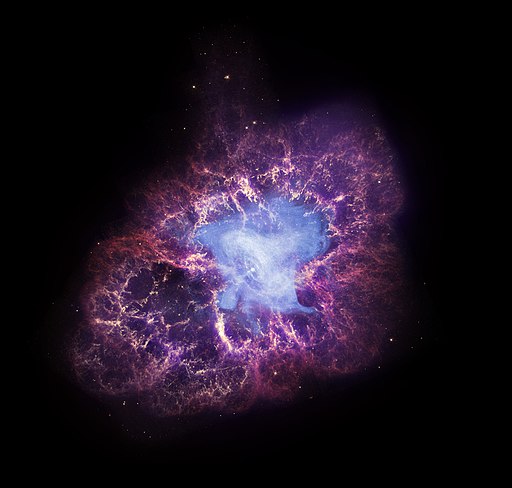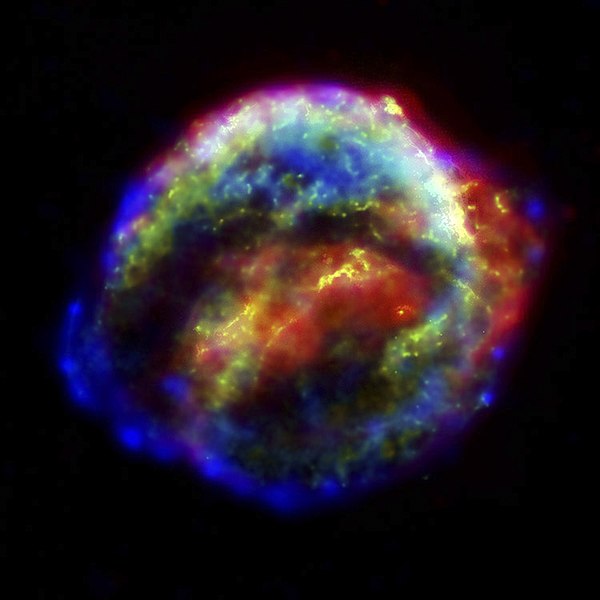What is a Supernova?
Written by Manya Pandey, a first-year undergraduate student.
This happens during the last stage of a really massive star, which is about to die. The explosions are very bright and super powerful.
Written by Manya Pandey, a first-year undergraduate student.
Do you know – stars die in loud, dazzling fireworks?
About Supernovas
A supernova is a loud bright explosion created when a star dies.
This happens during the last stage of a really massive star, which is about to die. The explosions are very bright and super powerful.
After the explosion, the star either turns into a neutron star or a black hole, or is gets destroyed. A neurton star is a collapsed core of a massive star.
Read: Scientists Release Picture of Black Hole in Our Milky Way
According to NASA (the American space agency), they are “the largest explosion that takes place in space”. After the explosion, all that remains is a dense mass called a neutron star or a black hole, through which nothing, not even light, can pass.
What do you mean die? How do stars die?
When a star has burned all of its hydrogen fuel (stars are usually made of hydrogen and helium), it starts to die – meaning that it expands to become a big giant. This could take millions of years and it could extend millions of kilometres across – depending on the size of the star.
Some basic facts to know about stars…
- A star is an enormous ball of gasses held together by a force called gravity
- Every star burns (shines) using its nuclear fuel.
- A white dwarf refers to a dying star that is almost out of its nuclear fuel.
Coming back to supernovae – how do they happen?
Supernovae (plural of supernova) happen mainly because of two reasons. Either when a star runs out of life force, or when it sucks in too much energy and explodes.
Here’s more
1. End of a star’s lifetime
As you know, stars shine by burning the hydrogen fuel present in their core but when a star runs out of this fuel, it enters the dying stage called “white dwarf”. During this, some of the outer gasses flow into the core, which gradually makes the core heavier. After a while, it gets so dense that the gravity can not hold it together then the star collapses and explodes.
2. In the case of binary stars
A binary star refers to a system of two stars that revolve around each other due to each other’s gravitational force.
Now in case one star is a white dwarf (a star in its dying stages), it sucks in the mass of the other star, and gradually becomes so heavy that the gravity fails. After which the white dwarf explodes in a supernova.
An interesting fact – one teaspoon of material from a white dwarf would weigh up to 100 tonnes.
How do scientists observe a supernova?
Special kinds of telescopes that can detect the different types of lights like, visible lights, x-rays and gamma rays are used to detect supernovae. These lights are during the explosion
At present Hubble Space Telescope and Chandra X-ray Observatory are used to capture and study supernovae
Even kids can detect supernovae!
You’ll be surprised to know that in the past kids have discovered supernovae too. For instance, a teenager discovered one in 2008 and in 2011 a Canadian 10-year-old spotted a supernova in a picture taken by an astronaut.
Some famous supernovae
1. The Crab Nebula

The Crab Nebula is the most well known of all nebulas. It was recorded for the first time in 1054 by Chinese and Korean astronomers. The explosion was so bright, that it was visible in daylight.
The image above puts together data from three of NASA’s Great Observatories – Chandra, Hubble and Spitzer. Together, these three telescopes captured a striking image of this amaxing nebula.
2. Kepler’s Supernova

Also known as SN 1604, Kepler’s supernova was the first one observed in our milky way galaxy via the naked eye.
Kepler’s Supernova, also sometimes known as Kepler’s Star is one of the few violent stellar explosions that we know to have taken placed in the Milky Way. A person named Jan Brunowski who was the assistant of Johannes Kepler – a German astronomer and mathematician – first observed the this in 1604.
Kepler then continued to study this till about 1606, when the supernova could not be seen to the naked eye.
Why are supernovae important?
When the star explodes, it releases gasses and elements like iron and carbon into the universe. Many of these elements gather up and make new stars and planets in space.
Quick facts…
- Supernovae last for a short time but they’re so bright that they can outshine galaxies.
- A supernova is so big that it can radiate more energy than our sun will in its entire lifetime.
- Supernovae create heavy elements in the universe
Also Read: Fun Facts About Solar Systems
I Kid You Not now has a large readership across India and also parts of the world. If you want to write for us, you can submit your story here. You can also apply to become a news anchor. Apply here



Comments